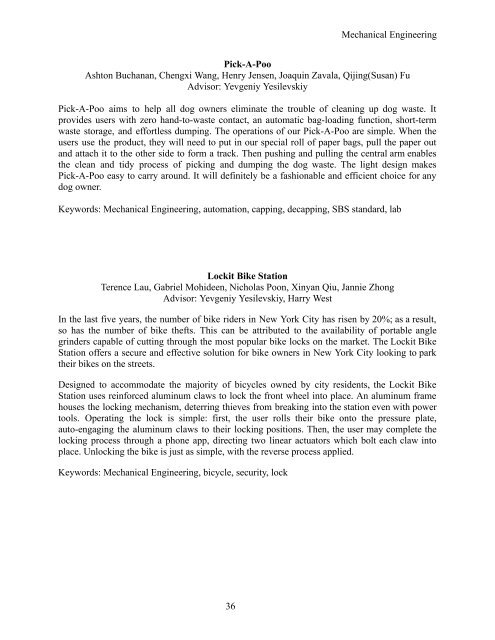Create successful ePaper yourself
Turn your PDF publications into a flip-book with our unique Google optimized e-Paper software.
Mechanical Engineering<br />
Pick-A-Poo<br />
Ashton Buchanan, Chengxi Wang, Henry Jensen, Joaquin Zavala, Qijing(Susan) Fu<br />
Advisor: Yevgeniy Yesilevskiy<br />
Pick-A-Poo aims to help all dog owners eliminate the trouble of cleaning up dog waste. It<br />
provides users with zero hand-to-waste contact, an automatic bag-loading function, short-term<br />
waste storage, and effortless dumping. The operations of our Pick-A-Poo are simple. When the<br />
users use the product, they will need to put in our special roll of paper bags, pull the paper out<br />
and attach it to the other side to form a track. Then pushing and pulling the central arm enables<br />
the clean and tidy process of picking and dumping the dog waste. The light design makes<br />
Pick-A-Poo easy to carry around. It will definitely be a fashionable and efficient choice for any<br />
dog owner.<br />
Keywords: Mechanical Engineering, automation, capping, decapping, SBS standard, lab<br />
Lockit Bike Station<br />
Terence Lau, Gabriel Mohideen, Nicholas Poon, Xinyan Qiu, Jannie Zhong<br />
Advisor: Yevgeniy Yesilevskiy, Harry West<br />
In the last five years, the number of bike riders in New York City has risen by 20%; as a result,<br />
so has the number of bike thefts. This can be attributed to the availability of portable angle<br />
grinders capable of cutting through the most popular bike locks on the market. The Lockit Bike<br />
Station offers a secure and effective solution for bike owners in New York City looking to park<br />
their bikes on the streets.<br />
<strong>Design</strong>ed to accommodate the majority of bicycles owned by city residents, the Lockit Bike<br />
Station uses reinforced aluminum claws to lock the front wheel into place. An aluminum frame<br />
houses the locking mechanism, deterring thieves from breaking into the station even with power<br />
tools. Operating the lock is simple: first, the user rolls their bike onto the pressure plate,<br />
auto-engaging the aluminum claws to their locking positions. Then, the user may complete the<br />
locking process through a phone app, directing two linear actuators which bolt each claw into<br />
place. Unlocking the bike is just as simple, with the reverse process applied.<br />
Keywords: Mechanical Engineering, bicycle, security, lock<br />
36








